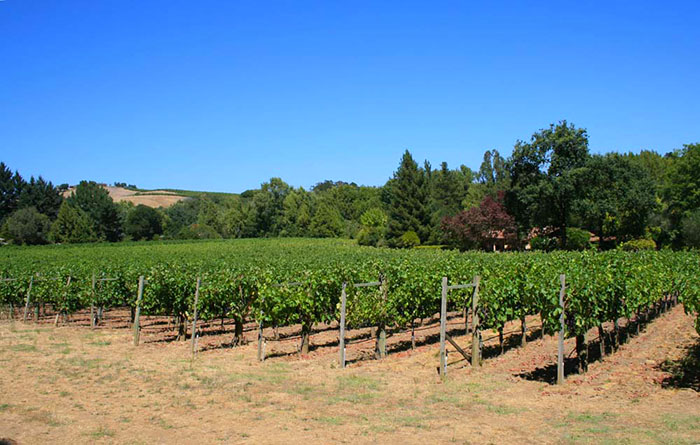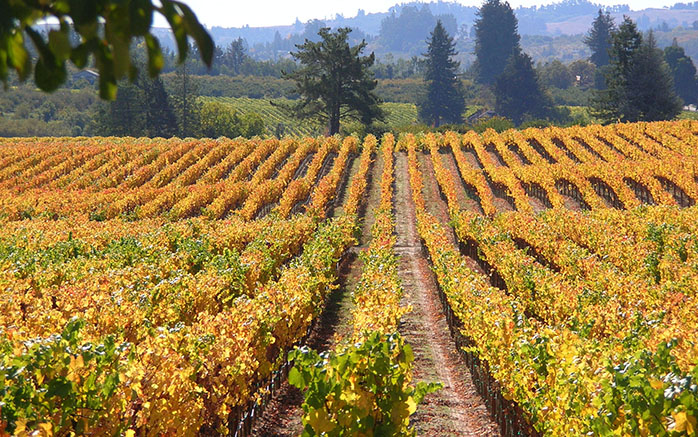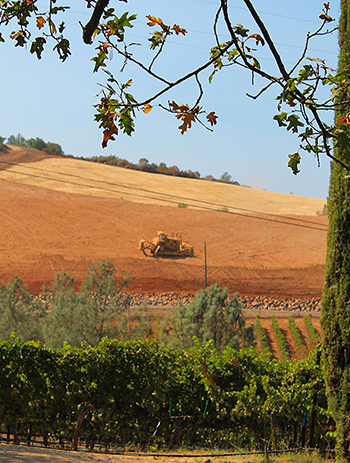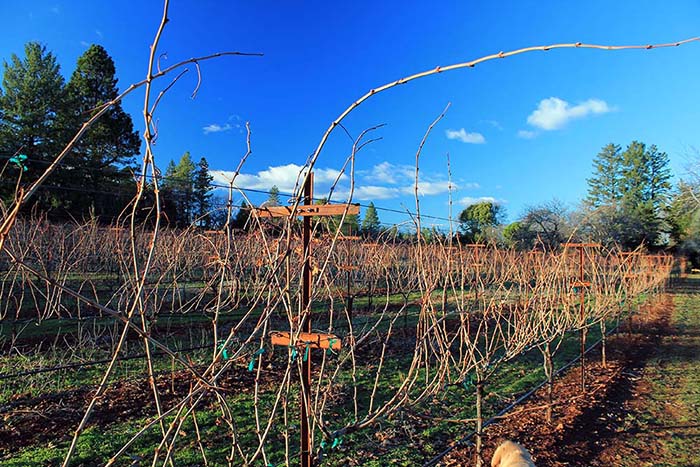Ask yourself: why am I buying a vineyard? This may seem like an obvious question but the answer could lead you in numerous directions not yet considered. What is the driver? Are you looking for lifestyle? Is there a desire to create the next super premium Cabernet, Pinot Noir or Chardonnay? Are you going to be hands off or do you want to be out in field getting dirt under your nails?
Short Course Guide To The Basics When Buying A Vineyard
My mantra is to help answer these and other questions so that I can point you in the right direction and help fill in the gaps along the way. This article covers a number of variables you will want to consider during your wine country search.

Climate Control
Depending on the micro-climate and soils, you should choose a grape varietal best suited for the conditions. Choose a varietal that can achieve higher quality than others (and is in demand). For instance, the Rutherford area of the Napa Valley has a warm – hot climate. The soils are perfect for Cabernet Sauvignon. On the other hand the Russian River Appellation in Sonoma County is considered to have a cool to warm climate. It has an abundance of gold ridge soil, a perfect combination for Pinot Noir and high end Chardonnay. This is why both Napa Valley Cabernet and Sonoma County Pinot Noir demand a premium. Of course if you wanted to, you can grow Cabernet in the Russian River Appellation and Pinot Noir in Rutherford. But that is not the highest and best use for a vineyard as each varietal thrives in unique conditions. Not to mention overall market perception of where they should be grown. At this point I’ll throw in the caveat that this is a very general guide because there are always exceptions and I can tell you from experience I’ve had a damn good Russian River Appellation Cabernet Sauvignon.
Most regions are broken up into Appellations or American Viticultural Areas (AVA). The difference from one Appellation to another mostly has to do with unique micro-climates, soils and geographic boundaries. Bordeaux varietals like Cabernet Sauvignon prefer a hot climate like in Rutherford, St. Helena, northern Yountville and other nearby Appellations in Napa County, or Alexander Valley in Sonoma county. However Pinot Noir and Chardonnay perform more favorably in a cooler climate like Carneros and the Russian River Appellations.
A Snapshot Of The Lay Of The Land
Both Napa and Sonoma Counties have incredible areas for cool climate grape varietals and varietals that thrive in the heat. The way it works in each “valley” is quite different but they have one thing in common, the marine influence or lack there of. In the Napa Valley the cooler climate grapes like Pinot Noir and Chardonnay are located in the Carneros region, the southern tip of the valley that sticks its toe in the San Pablo Bay. Because of the marine influence this area stays much cooler in the growing months than points north. To over simplify you could almost say that Carneros is cool, Yountville is warm, and areas north like St. Helena and Calistoga are hot. These changes give rise to the opportunity for different varietals to thrive in each micro-climate. Throw in the mountain districts like Diamond Mountain, Howell Mountain and Atlas Peak and things start to get even more interesting. With the mountain settings you have a narrower diurnal swing as the temperatures are generally warmer at night and cooler during the day than the regions on the valley floor. Don’t forget the proper exposure to the sun. So many options to choose from!
World Class Wine Growing Regions
Sonoma County also has a Carneros region that tips its toes into the Bay, but this is where most similarities begin and end between Napa & Sonoma. Sonoma’s broad expanse covers much more ground than its famous neighbor and has arguably many more nuances and opportunities. Where Napa Valley is essentially one large valley with mountain areas on each side, Sonoma County has numerous mountain ranges and even more small pockets of unique growing areas and conditions. Combine that with the Pacific Ocean lining the western boundary and you have ripe conditions for all types of possibilities. There are several cool climate growing areas in including Carneros to the south and the Sonoma Coast / Russian River Appellations to the west. With the ocean’s marine influence making its presence felt through the Russian River and Petaluma Gap, areas like Sebastopol and western Santa Rosa hold some of the premier Pinot Noir vineyards. As the cooling air dissipates areas like Bennett Valley have a more warm micro-climate that favors Merlot, Chardonnay, Sauvignon Blanc and even some Pinot Noir. Moving north and inland you can find excellent quality Bordeaux varietals in Sonoma Valley, Alexander Valley, Knights Valley, and Pine Mountain-Cloverdale Peak area.

Cost Benefit Analysis
Another quick point when thinking of buying a vineyard. All of these locations when combined with certain varietals create certain values, costs, income and expenses. For instance the Rutherford – Saint Helena areas in the Napa Valley will produce some of the highest quality Cabernet Sauvignon demanding the highest grape prices, and also the highest vineyard per acre prices. In Sonoma County, the same is true with the combination of Pinot Noir and the Russian River / Sonoma Coast Appellations… highest grape prices and highest per acre vineyard value.
Lifestyle – A Key Component
Whether you’re going to live in wine country full time or just stop by during harvest, make sure you enjoy the area you’re investing in. Does the area give you a good feeling, will it work for your family and or friends. Keep in mind, you may have trouble getting rid of certain friends and family once you relocate to wine country. It happens more than you think! Once you’ve decided on area, determine what wine grapes grow best in that location. Or, more likely than not, work with the vineyard that is already in the ground. If you like one area but the grapes you prefer are not ideal in that location, don’t fret… you can always buy fruit or juice from the premier location and use it for your purposes. Keep in mind there’s more than one way to find a happy medium when buying a vineyard.
Dollars & Cents – How Much Does It Cost To Plant A Vineyard
Raw Unplanted LandPlantable land values run a wide spectrum depending on the location, condition and what kind of infrastructure and permits are necessary to “break ground.” The prices could range anywhere from $30,000 to $400,000 for a raw acre of proven plantable land. An area like Rutherford in the Napa Valley would demand the high end of $400,000 / acre in contrast to the Pope Valley which could come in at $50,000 per acre. In Sonoma county you could find a range of $30,000 – $110,000 per acre for plantable land. The premium areas like the Russian River Appellation, Sonoma Coast and Green Valley Appellations demand the most per acre. Other areas will come in around $60,000 – $110,000 per plantable acre.
Planting A Vineyard
Rather than buying a vineyard planting a vineyard starts on the drawing board, of course after you’ve walked the land, checked the soils, confirmed the water… then it’s back to the drawing board. At this point you want to be working with a viticulturist who can help you determine the right varietal, spacing between vines and rows, appropriate exposure so on and so forth. The cost of the planting will depend on how steep the slope of the land is, how many

vines are being planted, the type of trellis and irrigation system that is needed along with many other factors. Planting costs can range anywhere from $40,000 acre over a three year period for a straight forward relatively flat piece of land. Costs can increase to upwards of $100,000+ per acre over a three year period for a very steep slope with lots of rocks and infrastructure to install.
One of the first steps will be to identify and order the vines and or rootstock. They can either be bench graft or field grafted vines. If you go the bench graft route your desired clone and rootstock will be combined and nurtured in the nursery. If you opt for a field graft approach, you would first plant the rootstock and let it grow for a period of time, and then later come in graft the selected clone on the rootstock in the field. This approach takes longer to mature but produces a stronger vine.
Next Steps
While the vines are gearing up to be planted its time to prep the soil based on your soils reports. This is usually determined by your trusted viticulturist who has already dug numerous pits through out the plantable area. They determine what nutrients and amendments should be added before planting. Once the amendments have been spread out and the land has been ripped, many times 3 – 5 feet deep, it is time to let it sit. Let the soil absorb the rains and enjoy the sun. This process allows the elements to blend together in order to create the optimal growing conditions for that particular site.
Spring is in the Air
Once Spring rolls around the land will be lightly ripped again. Discing the top layer and vegetation back in to the soil. Then it is time to lay out the vineyard design, marking where each vine will sit. Installing the irrigation system, trellis wires and end posts. Your viticultarist will determine the spacing between the vines and rows, and type of trellis system. Aslo, the types of soils you have and the vision for the vineyard, high quality or production.

Once the vines are planted it takes three to four years for the first harvest. Many times people refer to their first harvest as the third leaf, third year in the ground. Also, depending on what the grower is going for, some may choose to drop the first crop. They will wait until the fourth leaf to harvest for wine making. The harvest from the third leaf is small and usually not as quality as later vintages. You will see a steady increase in your production up to about the seventh year for average vineyards. This is where most vineyards hit their stride. If the site is in a mountain location or has more rocky soils, it may take longer for the vineyard to reach it’s full potential. When buying a vineyard it is important to gauge various time horizons.
Costs To Maintain
During the first three years, the cost to maintain the vineyard is rolled into the figures I already mentioned. The costs range anywhere from $40,000 per acre to $100,000 per acre. Once you’ve moved past the initial stage vineyard management should cost you anywhere from $6,000 – to $20,000+ / acre / year. This depends on where and what you plant. There are a number of high quality vineyard managers / farmers for hire so that should not be a concern. But as with most other things, do you research. Keep in mind that you often get what you pay for. Another option, is to start driving the tractor and learning the ropes. This way you can direct a crew and reduce your farming expenses. There are excellent viticultural classes in the local colleges that will help you take your education as far as you would like. Before buying a vineyard and jumping straight into the farming I would highly advise working with experienced professionals.
Current Grape Prices
After the largest harvest in history and impressive wine grape price appreciation over the last couple seasons we are in a market that looks to be healthy. It should be stable for the foreseeable future. When buying a vineyard it is important to know the wine grape market. Below are figures from the 2022 harvest. This will give you a sense of wine grapes that were sold under contract (most grape sales) price paid per ton. This does not include spot market grape sales or all varietals.
| County Average | Price Per Ton | | | | | |
| Napa County | | | | | | |
| 2022 | Trend | 2021 | 2020 | 2022 High | 2022 Low |
| Cabernet Sauvignon | $8,813 | + | $8,082 | $6,260 | $60,000 | $450 |
| Pinot Noir | $2,815 | + | $2,637 | $2,647 | $8,500 | $1,000 |
| Merlot | $4,525 | + | $4,032 | $3,217 | $27,592 | $429 |
| Zinfandel | $4,581 | + | $4,435 | $4,007 | $10,000 | $500 |
| Syrah | $4,658 | + | $4,251 | $3,686 | $17,500 | $1,200 |
| Chardonnay | $3,555 | + | $3,245 | $3,028 | $15,000 | $500 |
| Sauvignon Blanc | $2,930 | + | $2,635 | $2,453 | $8,000 | $1,000 |
| | | | | | |
| Sonoma County | | | | | | |
| 2022 | Trend | 2021 | 2020 | 2022 High | 2022 Low |
| Cabernet Sauvignon | $2,966 | + | $2,728 | $2,460 | $20,198 | $733 |
| Pinot Noir | $3,708 | + | $3,518 | $3,147 | $17,062 | $500 |
| Merlot | $2,113 | + | $1,960 | $1,590 | $20,198 | $200 |
| Zinfandel | $3,335 | + | $3,113 | $2,624 | $38,864 | $200 |
| Syrah | $3,038 | + | $2,871 | $2,472 | $7,464 | $100 |
| Chardonnay | $2,439 | + | $2,284 | $2,311 | $13,215 | $500 |
| Sauvignon Blanc | $1,921 | + | $1,730 | $1,554 | $6,373 | $900 |
*Source - Grape Crush Report Final 2022, California Department of Food and Agriculture
Important Questions To Consider
Now that you’ve decided you’re ready make your move here is a short list of important questions to ask:
Do you have a survey of the property?
Does a soils analysis exist?
What are the sources of water? i.e., wells, springs, reservoirs? Production info?
Is there a water analysis to test for bacteria, chemicals, or minerals?
If there is a reservoir, how many acre feet is it? What is the source that feeds it? By a spring or is it seasonal? Is there a permit for using the water?
What is the vineyard irrigation?
Does the owner have a vineyard layout showing: Varietals, Age, Rootstock, Clone, Spacing, # of vines?
What is the past production, yields in tons?
Prices paid per ton and who is buying the fruit?
Is there a grape purchase agreement or lease, and what are the terms?
Does the vineyard have a frost control system, overhead sprinklers or fans?
Are there any known diseases or infestations in the vineyard?
Ready, Set, Let’s Go!
Now that you have this short course of information for buying a vineyard we can start to take a deeper look into what will work for you. Along with your real estate search I have access to all of the experts to ensure that you’re making an educated decision.
Next Newsletter
Previous Newsletter
Some additional articles that might be helpful:
What is a vineyard really worth? It depends.
Wine Country Real Estate Building Blocks
Looking to Buy A Winery, Start Here
So where exactly is wine country?
Which AVA came first?
If you are serious about your wine country search, please contact us today. Last but least, here is link to more local resources.



